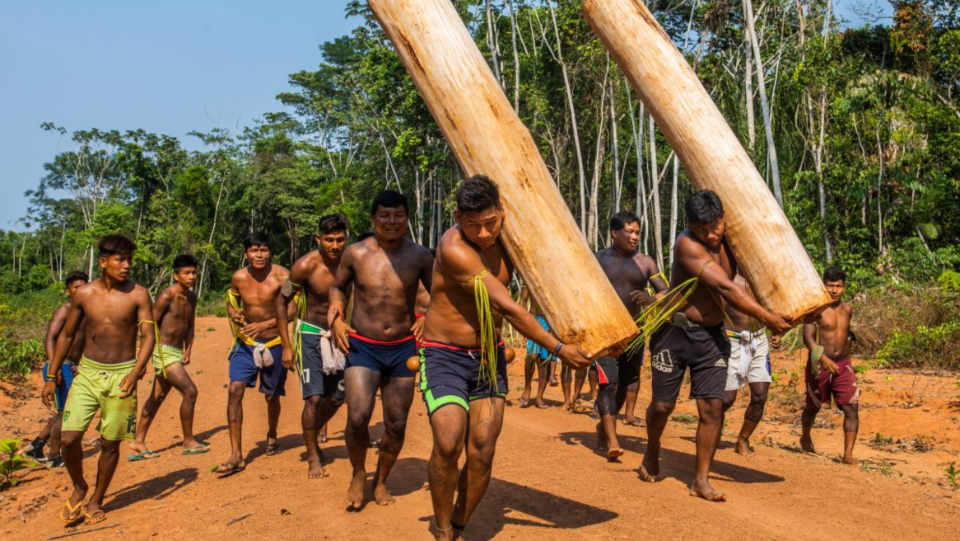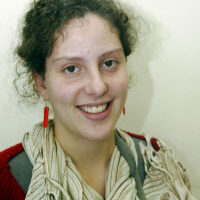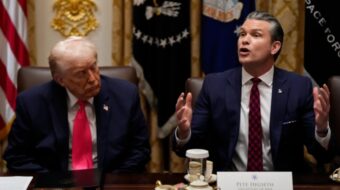
Two groups of men descend the unpaved road at a rapid, rocking gait. Under the intense midday sun, each carries the three-meters-long trunk of a buriti palm tree, weighing at least a hundred kilos. One man carries the trunk for some meters before another takes his place. They spell each other without stopping because they are competing in a tora race, a tradition among the Paraná warriors.
As the two teams get closer to the village, their speed increases, until one of the groups breaks away from the other, rushing toward the Men’s House, a wood and straw construction in the middle of the village, which is the finish line. Afterward, with both toras resting on the ground, everyone gets together to dance and sing. The women, their bodies painted, feathered ornaments on their arms, rattles of pequi seeds tied to their legs and skirts of glass beads, form a line and join the men in a circular dance.
The commemoration of 25 years since the Panará people repossessed their traditional territory was promoted by the Iakiô Panará Association, which represents them. It took place October 15-17, with traditional songs and dances, the tora race, bow and arrow contest, the moitará (an exchange of objects between event participants), a women’s meeting and important speeches by the Panará and their guests.
During the years of the military dictatorship (1964-1985), impacted by the construction of the BR-163 highway, the Paraná were transferred to the Xingu Indigenous Park despite their protests, where they lived in exile in their own country.
Twenty-five years ago, they returned to their ancestral territory, bringing a cycle of loss and tremendous pain to a close. The Panará are warriors and have many conquests to commemorate. Readers can watch the video made by Arewana Yudja and Kujãesage Kaiabi, from the Xingu+ Communicators Network.
“I was courageous. I was strong.” Akâ Panará speaks at the opening ceremony. “As a warrior, I was able to claim this piece of earth. If it was not for me, we would not be here. This is why I fought. I was not afraid of the white men. I was brave. I am happy to be hearing and celebrating our history.”
Akâ is an elder of his people and experienced his initial contact with white men in the 1970s. He is one of the few Paraná survivors from that era. During the opening ceremonies, he was joined by Steve Schwartzman, an anthropologist who acted together with the Panará and is the current coordinator of the EDF Renewables organization, André Villas-Boas, a founding member of the ISA, Sofia Mendonça, coordinator of the Unifesp Xingu Project, Douglas Rodrigues, a Unifesp physician who has been on the side of the Panará since the time they lived in the Xingu, Kanse Panará, Pasyma Panará and other partners, like Marisa, a nurse who has been active for years in the territory.
During the commemorations, the Panará also spoke out against the government of president Jair Bolsonaro. See the following video: “Indigenous Panará people say, “Out with Bolsonaro!”
Contact
“Let’s begin at the beginning,” says Akâ, sitting on a wooden bench in front of his house. “I was born where where Matupá [in Mato Grosso] is today, in the big village of Inkasã,” he continues. Akâ’s childhood preceded his people’s contact with the white men. The Panará lived spread out in dozens of villages in a region that included most of what are now northern Mato Grosso and southern Pará states, including the current cities of Colíder, Matupá, Peixoto de Azevedo, Guarantã do Norte and southern Altamira. They speak the Panará language, a branch of the jê language tree.
“Before the white man came, I was happy, I hunted and played without having to think about enemies. I was free and lived joyfully,” he says. The Panará held tora races, feasts, hunted and fished at will.
However, this was the era when the Indigenous peoples of southern Mato Grosso had already been contacted by the Villas-Boas brothers (Cláudio, Leonardo and Orlando).

In 1961, the Xingu Indigenous Park (today the Xingu Indigenous Territory) had been demarcated to shelter and protect all these peoples, some of them, like the Ikpeng and the Kawaiwete, brought from other areas. This story is told in the film, Xingu, accessible on Netflix.
The Panará had not yet been contacted by the Villas-Boas brothers. This happened only after they had entered the generals’ path. In 1973, the military government ordered that Cláudio and Orlando Villas-Boas undertake an expedition to contact this people and remove them from the route of the BR-163 highway which was meant to link the cities of Cuiabá and Santarém.
“We had set out to hunt and heard the sound of an airplane,” Akâ recounts. The Panará grabbed their bows and arrows. “There was tumult in the village, we were startled by the noise of the low-flying plane.” Next day, the plane returned and the Panará tried to pierce it with their arrows. Probably, they were military planes flying back and forth from the army base in the Cachimbo mountains.
“We were very worried. People from other villages came and joined together to confront this enemy,” Akâ continues. On one occasion, the Panará men encountered and killed a white man with their arrows. For days, they continued to hear the noise of airplanes. Then they began to find objects in the forest, left there by the wilderness explorers as offerings they hoped would eventually lead to an encounter.
Kreton Panará, who also lived through this era, says that he cut himself with a knife he found in the forest because he had no idea what purpose it served. After coming across another white man in the woods, Kreton says that the Panará gathered to discuss what should be done. “Shall we wait or shall we kill them?”
At that time, the Panará migrated to a more distant village with the intention of fleeing from the white men. But the Villas-Boas brothers continued their attempts to come closer. One day, they came across the white explorers headed downriver in two large canoes and decided to speak with them. Cláudio approached them and one of the Panarás took the machete from his hand. Contact was made.
“We cooled down, stopped arguing and began to accept things. The young ones said, ‘they came here to make friends with us, not to kill us.’ And the rest of us agreed,” Akâ says.
The contact brought death, however. “We were dying in the morning, in the afternoon and at night,” Kreton remembers. “Influenza and measles devastated the Panará. “Few people survived,” Akâ mourns.
At least 176 Panará died as a result of illnesses contracted after contact with the outsiders, between 1973 and 1975. When the highway began to be constructed and hundreds of workers moved to the region, the consequences were even worse. Kreton recalls the first time the white men gave him and the other Panarás cachaça. We didn’t know about alcohol and fell down sick with drink.”
In 1974, the Villas-Boas brothers decided to transfer the Panará to the Xingu Indigenous Park. According to Akâ, they were mistaken, thinking there would be other Panarás living there. It was a time of exile. The forest there was very different from the one to which they were accustomed. The Park was not nearly as good for hunting and it was difficult to find the fruits they knew and depended on.

Sofia Mendonça relates an episode in which the Panará almost died from eating wild manioc, a variety eaten by the other Indigenous people in the park but whose poison the Panará did not know how to neutralize before consuming it. This is just one of many stories of their distress in exile.
In the twenty years they remained in the Xingu Indigenous Park, the first people the Panará lived with were the Kawaiwete. After that, they lived with the Kaiapó and after that with the Khisêtje. In their final years in the park, they lived in their own villages. But they never felt at home.
At the beginning of the 1990s, they made up their minds to fight to return to their territory. This whole saga is described in detail in the book Panará – A Volta dos Índios Gigantes, published in 1998, as one of the actions meant to support the demarcation of the Panará territory. The site, created to celebrate twenty years of return, also gathers important testimony about their saga. Here is a map that charts the dislocations of the Panará people during the years of contact, transference and return:

“The white man ate our land”
Panará leaders like Akâ and Kreton attempt to articulate the journey of return. According to them, the National Indian Foundation (FUNAI) was of no help at all. Then they found partners in Steve Schwartzman, who had written his doctoral dissertation in anthropology based on field work among the Paraná and spoke their language, and the Indigenist André Villas-Boas who would found the Socioenvironmental Institute (ISA) some years later.
The first step was to create a mission of recognition. Six Panarás together with Steve and André made a bus trip to the municipality of Peixoto de Azevedo in Mato Grosso. What was before a village in the forest was now a city, fields of soy beans covering grasslands demolished by miners. “The white men ate our land,” Akâ complains.
Then and there, they asked to meet with the authorities responsible for the change. They were upset and demanded an explanation. Next, Akâ, Kreton and Kokè decided to fly over the territory. Of the eight former principal villages of the Panarás, six had been destroyed. But a portion of the forest farther north was still preserved.

“I was very happy,” Akâ says. From that point on, an intense struggle to demarcate a parcel of still preserved Panará Indigenous Land began as well as a long process within the FUNAI.
Between 1994 and 1997, the Panará began their return journey. In 1997, the celebrated their definitive return in Nãsepotiti village and the end of their days of exile, illness and suffering. In 2001, the territory was finally physically demarcated and named by the president of Brazil.
Future calm, challenges and threats
When they left their territory and went to the Xingu Indigenous Park, there were only 74 surviving Panarás of the more than 700 from before contact was made with the world outside. They staggered into the park. During the years of transference, the population grew hardly at all. In 1994, there were around 170. Since they have returned, the population has grown: now there are 704 Panarás, a number similar to the pre-contact populace.
Kunity Panará, a 38-year-old leader who grew up next to the Kayapó and came to the Panará Indigenous Territory when he was 16, speaks of return to the calm. “Fishing is easy. Hunting is easy. We eat a lot of fruit which is our traditional food. There’s lots of açaí, cacao, yapanitu, sotiv, pakÿ. The older people say that the land and the forest in the Xingu were different, not many good things to eat. Lots of people died there.”
Besides being a leader, Kunity is a communicator on the Xingu Network+. He spoke with the ISA reporter in one of the classrooms of the Nãsepotiti village school, one of the places where the wi-fi connection is stronger. This means a lot of young people hang out there to connect to the internet.
In the last 25 years, the Panará have managed to revive various traditions lost in the era of exile. Among them, their traditional manioc gardens which are round and among the most beautiful in the region. In 2015, the Panarás organized a traditional garden competition, described in the book Kâprepa puu popoti hãkia – Book of the Round Panará Garden, didactic material for the village schools.
“Everyone working together in the garden. Folks get together to hunt, fish, women well organized to deal with the food preparation. Everyone working together. We liked this organization a lot,” according to the communicator.
He briefly describes the main foods: Manioc is the basic foodstuff, so tapioca and flour are always available. Peanuts are saved for the rainy season, to add to the tapioca and enrich the porridge. “Peanuts strengthen your body for every kind of motion.” There are also yams, corn, watermelon, bananas, papaya and pineapple.
Nevertheless, food sovereignty remains a concern. The Panará Indigenous Land is close to cities like Guarantã do Norte and Peixoto de Azevedo. “White people’s food is making us weak. We are worried about this. We are discussing bringing back stronger traditional foods,” Kunity claims.

Kreton Panará also resents the spread of white cultural influence. “Today, everybody has a white man’s haircut,” he complains. After all his people have been through, he fears that, devoid of their culture, they will lose their territory as well.
During the days of their festival, Kreton called on the Panará youth to view their traditional culture as a worthwhile cause. He is concerned that, with the population surge after the return to the traditional territory, the majority of Panarás today are under 25. There are few surviving elders, and the maintenance of the traditions has been a challenge.
This concern was especially shared by the women. During the festivities, they had a space set aside to express their opinions. In the middle of the village, in the place known as “The Men’s House,” the Panará women and their female guests expressed their desire to get out of the village more, to broaden their political activities and their representation in spaces of struggle. And also the need to secure the traditional culture.
“The men need us,” one of the principal female leaders, Kwatum, insists. “We are going to make things right. I have relatives who no longer want to decorate their bodies or participate in the culture. But it is only this way, with our culture, are we going to have power. We have to stay united,” she continues. “We need more festivities, we have to teach the young ones to sing.” She recalls that her father taught her to participate in cultural celebrations. “My father brought happiness. I am going to continue in the way that my father taught me.”
Pakiaprin, another important Panará spokeswoman, makes it clear that she wants women to occupy places of political representation in the Indigenous struggle and in events outside the village.
“We women are strong, we have lots to say. We have to start to get out [of the village] and, for us to do this, the men must also take care of the house,” she says. “The party was a bit sad, because there are no more elders, the oldest ones who had the strength to animate us have left us. Now, we are going to have to hang on,” she announces.
Sãso Panará also took up the matter of traditions. According to her, the changes outside are coming to the villages, and the Panará people must unite to block this. “I want my culture to be represented in our feast days. The women must have power to make sure the culture survives. With strong women, we will continue to be strong, claims Sowakriti.
Even in an adverse context like that of the last four years, the boundaries of the Panará Indigenous Land were defended. There are no signs of the invasion of miners, illegal land grabbers and lumberjacks as there are in other territories. Even so, the Panarás fear for their piece of the forest.

Kunity speaks of the continuing encroachment of agrobusiness plantations and of the contamination of the headwaters of the rivers by toxic fertilizers. “We are worried about the animals in the bush and the fish in the rivers. We are going to have to keep fighting to maintain our way of life the way it is now so that no miners or lumberjacks enter our lands. These kinds of kubens (non-Indigenous outsiders, in Kayapó) spoil our natural resources. Human beings who live in the city also need nature. The world needs nature to survive,” he concludes.
To learn more about the Panarás, see, besides links provided above, Protocol of Consultation of the Panará People.
The original article was published by the ISA (Socioenvironmental Institute) on Nov. 21, 2022. Translated from Portuguese for People’s World by Peter Lownds.










